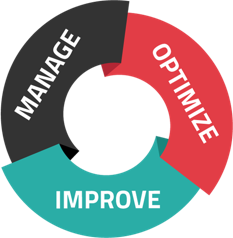
If you thought working from home would protect you from the security risks inherent in day-to-day business, you're probably not too thrilled right now. The unfortunate truth is that nowhere is safe--not unless you make it safe. Here are a few of the top security risks to look out for in 2023 and what you can do about them.
Biggest Security Risks in 2023
Working remotely is no longer a new idea for most people; employees have had time to settle into the concept and into their home offices. But as WFH and hybrid work become the norm, so too do additional security risks.
Here are a few things you need to look out for, even if just one employee in your company works remotely:
Email Scams
Email scams are nothing new, but they can get a bit more creative when targeting the work-from-home environment. After all, you can't lean over to the next cubicle and check if a colleague sent a particular message; you're more isolated from security support and--at least in a hacker's eyes--potentially more likely to lower your guard for the sake of convenience.
Phishing Scams
Phishing scams are also a familiar problem. They can disguise themselves as emails, text messages, ads, and all kinds of online content. The problem is that, when working remotely, you rely more completely on digital communication--which means you're constantly exposed to opportunities for phishing and similar security risks.
New Attacks
Working from home introduces entirely new scenarios, setups, and--unfortunately--opportunities for hackers to strike. With expanded attack surfaces and workforces physically separated from their IT teams, the digital bad guys are finding new ways to cause trouble. The problem with this is that your existing best practices and security solutions may not be designed to protect against these particular evolutions.
Unsecured Connections
When working remotely, it's tempting to connect to the free Wi-Fi at your favorite coffee place, right? Unfortunately, these unsecured connections can put work data at risk, even if you connect for just a moment.
Personal Devices
Personal devices themselves aren't necessarily any better or worse than work devices. The issue is with how those devices are used outside of work--because you've probably downloaded an app or accessed a website, even just for social media, that you wouldn't use on your professional machine. This can create a risk environment that you've never had to contend with before.
Security Best Practices for Work-From-Home Employees
Looking for ways to stay smarter than the digital bad guys? Here are some security best practices to get you started:
#1: Stay Vigilant
This one seems easy, but that's not always the case. After all, comfort can breed complacency--and if you're used to your home's tech setup, you might overlook vulnerabilities or risks that you'd never miss in an office setting. Stay vigilant and protect devices, data, networks, and anything else that interacts with work data.
#2: Use Password Managers
Password managers help step up your password game. You won't be tempted to write down any codes or use easy words because you think you'll be able to remember them; password managers do the work for you--which means you can use strong passwords that you'd never recall otherwise (like random strings of letters, numbers, and other characters).
#3: Use Smart Communication Solutions
Document management and similar solutions can help you create a shared digital workspace and data repositories. That means all of your information will live on one place--generally in the cloud--instead of on your personal devices. This doesn't just help improve work-from-home security; it also simplifies organization, communication, collaboration, and more.
#4: Choose Tools Wisely
You have a lot of options when it comes to chat software, email providers, video conferencing, cloud platforms, and more. To make home work environments as safe as possible, make sure you only use tools that have been properly vetted and accepted by IT decision-makers in your company. Even if you use a different app for personal data sharing or communication and have never had an issue, stick to the script and follow organizational protocol to make things easier for yourself and the IT team or provider helping protect your setup.
In conclusion, work-from-home security needs aren't going anywhere. Your best bet is to think outside the box and get ahead of hackers before they get ahead of you.
Does your business need help supporting or securing a work-from-home environment? Contact us today!



